Howdy all! It’s time for our regular monthly progress report. Let’s get right to it!
Feet and palm rest design
András has been busy designing the feet and palm rest of the UHK. The current design is close to final, so we’re excited to show it off.
But first, please fasten your seatbelts. The UHK is highly modular and configurable in nature and the feet and palm rest are no exceptions. There are a lot of combinations of feet configuration so let’s dive in!
The design
There are 4 feet mounting positions per keyboard half located in the corners of the halves:
When using the palm rest, the number of feet mounting positions (4) is unchanged, but their location spreads across a larger area because the bottom 2 feet per keyboard half are mounted to the palm rest:
A foot can be mounted with 3 screws and can be rotated in 90 degree increments:
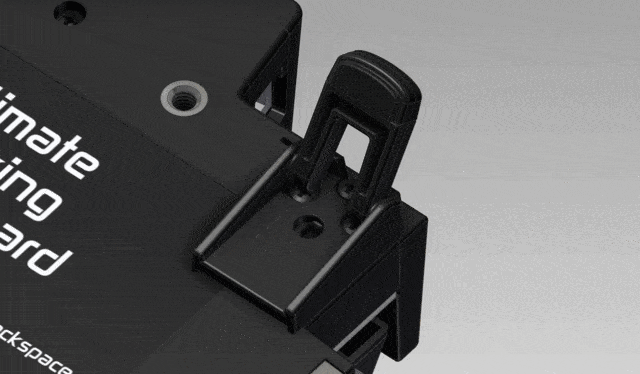
In any of the 8 positions, a feet can be unmounted (no elevation), mounted and closed (slight elevation), or mounted and opened (large elevation):
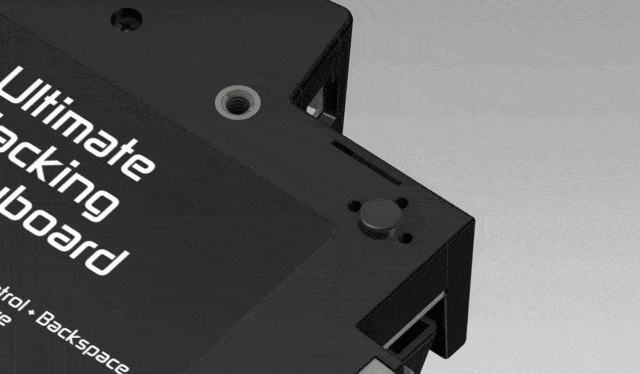
The bottom of the feet are rubberized, even sideways, and the UHK has its own small rubber feet so the keyboard won’t slide in any configuration:
The palm rest is fixed to the keyboard with 2 screws per keyboard half, screwed into the stainless steel inserts of the UHK:
Given the number of combinations, we can’t go over every possibility, but we’d like to highlight the most popular ones.
Positive tilting
4 closed feet are used in the top positions of this configuration. The palm rest is not featured on these pictures but you can use it if you want to.
[fusion_builder_container hundred_percent="yes" overflow="visible"][fusion_builder_row][fusion_builder_column type="1_1" background_position="left top" background_color="" border_size="" border_color="" border_style="solid" spacing="yes" background_image="" background_repeat="no-repeat" padding="" margin_top="0px" margin_bottom="0px" class="" id="" animation_type="" animation_speed="0.3" animation_direction="left" hide_on_mobile="no" center_content="no" min_height="none"]
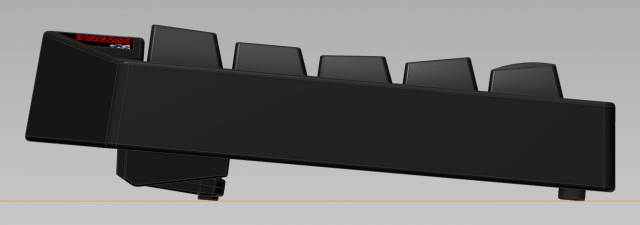
[/fusion_builder_column][fusion_builder_column type="1_1" background_position="left top" background_color="" border_size="" border_color="" border_style="solid" spacing="yes" background_image="" background_repeat="no-repeat" padding="" margin_top="0px" margin_bottom="0px" class="" id="" animation_type="" animation_speed="0.3" animation_direction="left" hide_on_mobile="no" center_content="no" min_height="none"]
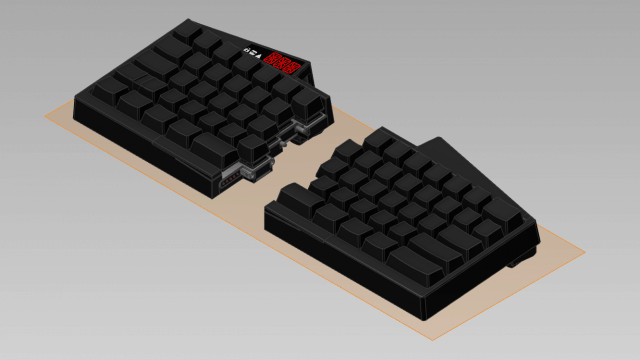
[/fusion_builder_column][fusion_builder_column type="1_1" background_position="left top" background_color="" border_size="" border_color="" border_style="solid" spacing="yes" background_image="" background_repeat="no-repeat" padding="" margin_top="0px" margin_bottom="0px" class="" id="" animation_type="" animation_speed="0.3" animation_direction="left" hide_on_mobile="no" center_content="no" min_height="none"]
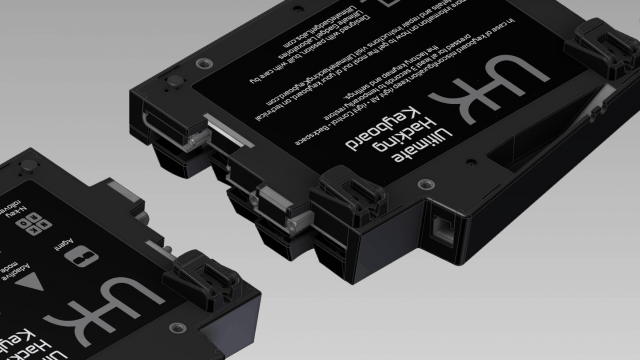
Negative tilting
In this configuration, 4 closed feet are used in the top positions and another 4 opened at the bottom positions mounted to the palm rest.
[/fusion_builder_column][fusion_builder_column type="1_1" background_position="left top" background_color="" border_size="" border_color="" border_style="solid" spacing="yes" background_image="" background_repeat="no-repeat" padding="" margin_top="0px" margin_bottom="0px" class="" id="" animation_type="" animation_speed="0.3" animation_direction="left" hide_on_mobile="no" center_content="no" min_height="none"]

[/fusion_builder_column][fusion_builder_column type="1_1" background_position="left top" background_color="" border_size="" border_color="" border_style="solid" spacing="yes" background_image="" background_repeat="no-repeat" padding="" margin_top="0px" margin_bottom="0px" class="" id="" animation_type="" animation_speed="0.3" animation_direction="left" hide_on_mobile="no" center_content="no" min_height="none"]
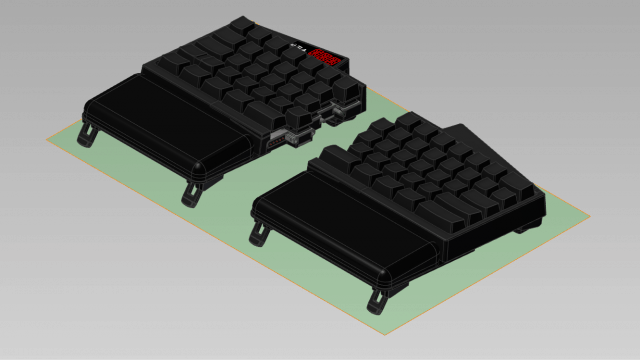
[/fusion_builder_column][fusion_builder_column type="1_1" background_position="left top" background_color="" border_size="" border_color="" border_style="solid" spacing="yes" background_image="" background_repeat="no-repeat" padding="" margin_top="0px" margin_bottom="0px" class="" id="" animation_type="" animation_speed="0.3" animation_direction="left" hide_on_mobile="no" center_content="no" min_height="none"]
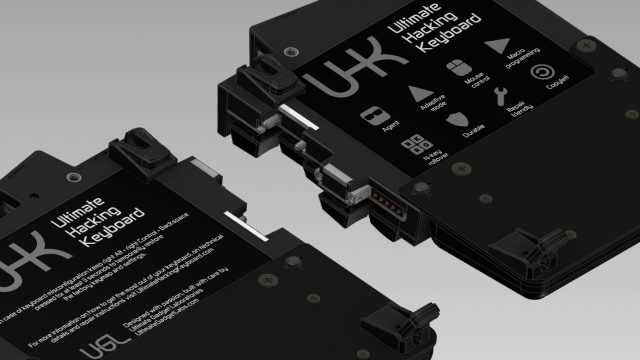
Tenting
4 opened feet are used in the inner positions and oriented towards the center of the keyboard.
[/fusion_builder_column][fusion_builder_column type="1_1" background_position="left top" background_color="" border_size="" border_color="" border_style="solid" spacing="yes" background_image="" background_repeat="no-repeat" padding="" margin_top="0px" margin_bottom="0px" class="" id="" animation_type="" animation_speed="0.3" animation_direction="left" hide_on_mobile="no" center_content="no" min_height="none"]

[/fusion_builder_column][fusion_builder_column type="1_1" background_position="left top" background_color="" border_size="" border_color="" border_style="solid" spacing="yes" background_image="" background_repeat="no-repeat" padding="" margin_top="0px" margin_bottom="0px" class="" id="" animation_type="" animation_speed="0.3" animation_direction="left" hide_on_mobile="no" center_content="no" min_height="none"]
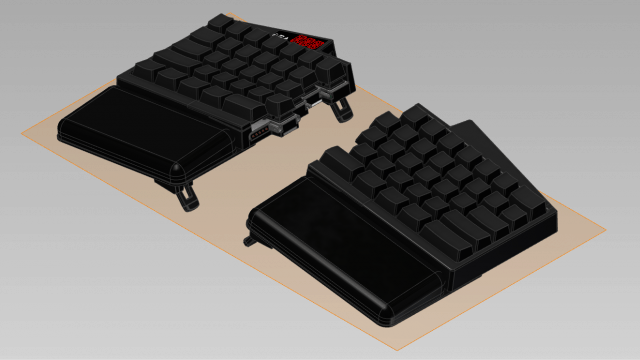
[/fusion_builder_column][fusion_builder_column type="1_1" background_position="left top" background_color="" border_size="" border_color="" border_style="solid" spacing="yes" background_image="" background_repeat="no-repeat" padding="" margin_top="0px" margin_bottom="0px" class="" id="" animation_type="" animation_speed="0.3" animation_direction="left" hide_on_mobile="no" center_content="no" min_height="none"]
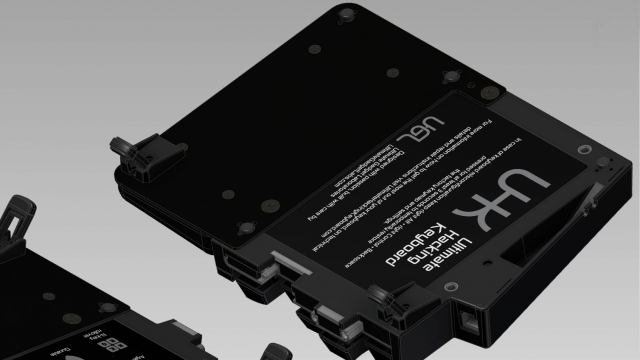
There are so many possibilities that we’ll surely end up writing a manual just on this topic. Stay tuned!
Mold and cutting tool progress
It is apparent that our Serbian contractor is hard at work. This is the sheet metal contour cutting and bending tool. It’s already functional, but we have to wait for the assembly of the rest of the tooling so that the holes of the MX switches will be cut, too.
And this is the injection molding tool of the case buttons which is also functional:
We’re happy about the progress of our Serbian contractor and can’t wait to see even more hunks of steel.
The 6th generation PCBs are being fabricated
Lately, I’ve been working on redesigning the schematic and PCBs of our latest prototype. These are the fruits of my labor:
[/fusion_builder_column][fusion_builder_column type="1_1" background_position="left top" background_color="" border_size="" border_color="" border_style="solid" spacing="yes" background_image="" background_repeat="no-repeat" padding="" margin_top="0px" margin_bottom="0px" class="" id="" animation_type="" animation_speed="0.3" animation_direction="left" hide_on_mobile="no" center_content="no" min_height="none"]
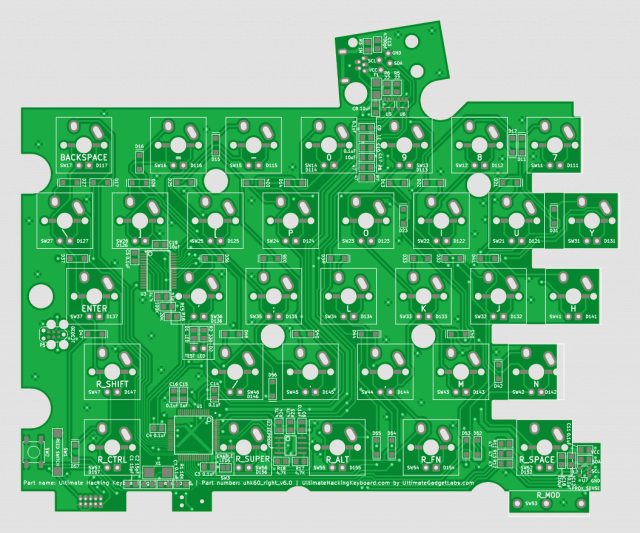
[/fusion_builder_column][fusion_builder_column type="1_1" background_position="left top" background_color="" border_size="" border_color="" border_style="solid" spacing="yes" background_image="" background_repeat="no-repeat" padding="" margin_top="0px" margin_bottom="0px" class="" id="" animation_type="" animation_speed="0.3" animation_direction="left" hide_on_mobile="no" center_content="no" min_height="none"]
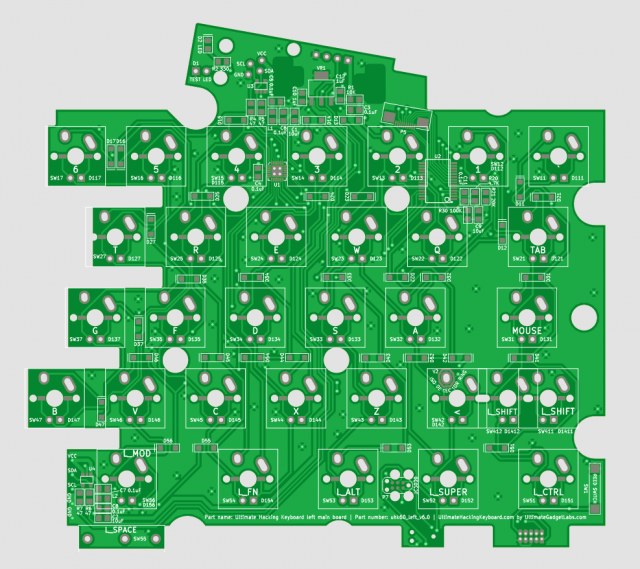
The improvements are plentiful, featuring:
- the super powerful MK22FN512VLH12 and MKL03Z8VFK4 MCUs
- IS31FL3731-SALS2 LED driver ICs per keyboard half allowing for per LED backlighting (we can’t provide LEDs and translucent keycaps yet but the ICs will be on board)
- 2x5 0.05” ARM programming header + Tag-Connect TC2030-NL header + TC2030 header per board for extra developer goodness
- optionally solderable reed switch per board to reset the MCU without disassembling the case to make it easy to hack the firmware even if jump to bootloader feature gets screwed
- optionally solderable I2C breakout header for developing modules in a breadboard friendly fashion
- optionally solderable test LED per board for debugging purposes
- pogo pins and I2C (versus the previous UART protocol) between the keyboard halves enabling the use of modules mechanically and electronically
A small batch of these boards are being fabricated right now at Eurocircuits and can arrive in any moment. I’m also about to order loads of components real soon which will be soldered onto the boards. These PCBs are supposed to resemble the final production boards very closely, so we’ll make sure to give them a fair amount of testing.
If you are one of those people who grok electronics please don’t hesitate to check out our electronics GitHub repo and give us feedback about the schematic and boards. We consider every single suggestion as we really want to get the design right.
Progress on Agent
Agent has been heavily refactored lately as we port the legacy jQuery codebase to Angular 2 step by step. This is one of those things that’s hard to notice by looking the application but it’s very significant regarding the long-term development of Agent.
This brings me to the star of the month. Give it up for Mr Nejc Zdovc from the beautiful town of Celje, Slovenia!
My name is Nejc Zdovc and I have been programming for the last seven years. I have a Master’s degree in Computer Science and Information Technologies. I was drawn to Angular 2 community last year and ever since, I’ve enjoyed pushing its boundaries. At the beginning of this year, I was having wrist problems and that’s why I was looking for a new ergonomic keyboard. I stumbled on the UHK and, with a little research, I found out that this is an awesome project, so I decided to start contributing. For the last few months I have been helping József with Agent.
Nejc has been helping out a ton with the Angular 2 port. Previously, only keymaps were managed by Angular 2, but he made the whole application governed by Angular 2 by componentizing it. He ported the side menu to Angular 2 and wrapped select2 into a component. This is serious progress and requires a lot of dedication. The work is not over yet but his help has been a quantum leap forward.
You know what’s crazy? Nejc and Sam don’t have a UHK at their hands yet and still, their contribution has been above and beyond expectations. I wouldn’t have expected developers contributing substantially before we deliver the hardware, but apparently it’s already happening. This is Free and Open Source at its best, folks! I can’t even imagine what will happen after delivery. I’d love to see our GitHub repos blown away by contributors!
As a token of our appreciation, Nejc and Sam will get a well-deserved developer unit soon, then eventually a final UHK with all the bells and whistles. It’s really the least we can do for them.
We’ve just arrived to the end of this update. I hope you enjoyed it, and talk to you on 2016-08-18.[/fusion_builder_column][/fusion_builder_row][/fusion_builder_container]
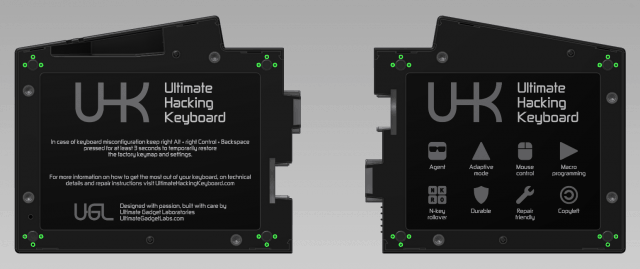
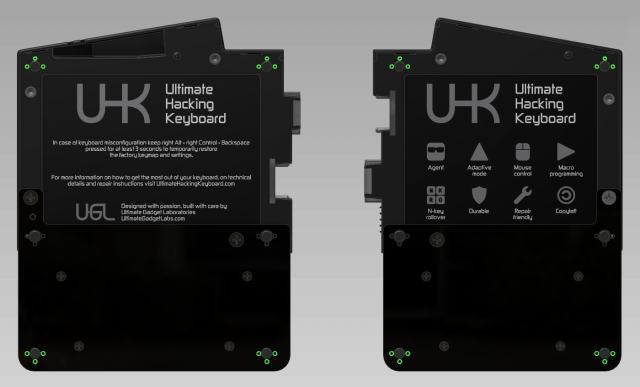
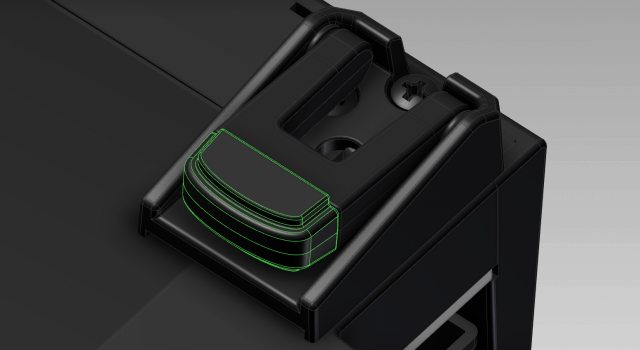
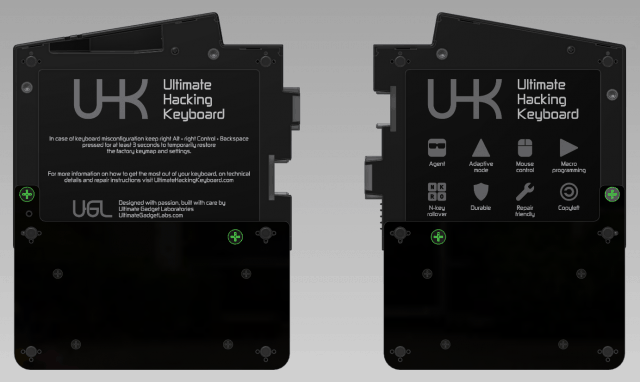
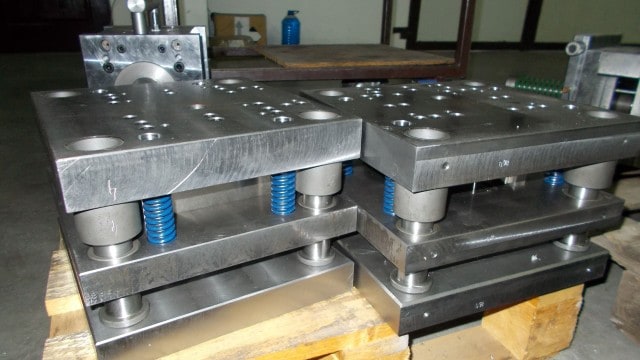
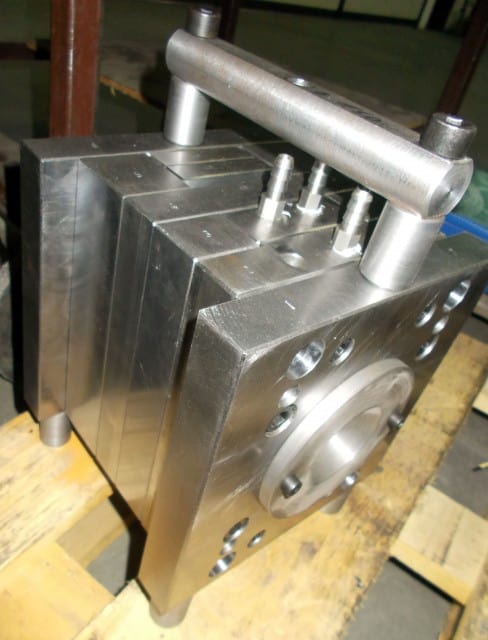

29 Responses
How's the test keyboard with the 3D printed frame?
Hi Cedrick,
Right now, we have 3 functional and 1 nonfunctional prototypes, each with a 3D printed case. They're doing great, althought some of them are showing signs of wear. We'll also 3D print the feet shortly.
Any idea when everything is production-ready and shipping can start? I hardly can wait any longer :-(
Hi EdbO,
We plan to elaborate on the schedule in our upcoming update. We'll be able to provide a more accurate estimate then. Until then, we proceed as quickly as we can.
Hi Laszlo:
Just curious, how's the state of the UHK modules (such as the trackball unit, etc.) going? Not that it's critical for launch, but I don't think there has been an update about that for a while. Is it still planned to release with the UHK or will you guys have more time to devote to it once the keyboard itself makes its first release?
Hi Sonictk,
Good point! Please let us elaborate about the modules in detail in our next update. We've already planned to talk about them.
Can you post some pictures or a video of the 3D printed models and describe how they are going to be different from the injection moulded ones?
Hi Ced,
The feet are yet to be printed but only the color and surface quality are noticable differences regarding the 3D printed objects vs the injection molded ones. We'll post pictures about the 3D printed feet as soon as we can.
Hi,
great to have so many options to position the keyboard with the feet.
Will the feet be included with the keyboard or with the palm rest?
Regards
Stefan
Hi Stefan,
The feet will be included with the keyboard, although we strongly recommend the palm rest for negative tilting and tenting for proper ergonomics.
Are there SDL files for the keyboard anywhere so people with 3D printers can print them and get a feel for the size?
Hi Derek,
I assume you mean STL, not SDL files. We'll provide them eventually. According to our community promise we'll publish the CAD files 5 years after the delivery of the first batch.
Hi!
With regard to your response to Derek, if a keyboard breaks 2 years after it is shipped, but the CAD files won't be released for another 3 years, that essentially means the keyboard will not be repairable for that 3 year period, right? That would give the buyer the choice of either waiting 3 years, purchasing a replacement keyboard from you, or of purchasing a replacement keyboard elsewhere.
Hi Bob,
There is also the option of purchasing a replacement keyboard case from us. We'll sell parts including cases of every color.
After seeing this I'm even happier that I ordered the palm rest :D
For those uf us who did, will it be shipped together with the keyboard? Or will it be done separately?
Glad you're happy about the palm rest, Fran! :)
The palm rest will be shipped with the keyboard. Separate boxes within a larger package.
Your "tenting" is awfully shallow. Tenting a split keyboard generally means something more significant, like 45 degrees (which you need for a truly neutral wrist rotation). Are there plans to offer feet that would enable real tenting? Have you looked at any possible ways for people to rig up such a setup in the interim until such feet may be available?
Hi Eric,
I'm interested where did you get the 45 degrees tenting angle from. I'm asking because pretty much every tentable keyboard on the market only allows for about 10 degrees, and certainly no more than 15 degrees. Only a single one allows precisely for 90, and none supports 45 degrees.
That being said, the opportunity is there for tinkerers in the form of stainless steel inserts and additional screw holes, so such legs can be definitely 3D printed or fabricated in other means. We're not sure whether we'll design additional feet. If the demand is strong we'll definitely consider it.
Well the 45 was rough guess at the angle of the keyboard currently in front of me and what feels like a neutral wrist angle to me personally. This is Goldtouch keyboard, and looking it up, it maxes at 30 degrees, though I've managed to alter it to get it slightly steeper (probably 35-40 actually). I've also seen kits for tenting the Kinesis Freestyle to a similar degree.
But looking at what's out there again, I see you're right that most of them tent more shallowly. But try holding your hands out where your keyboard would be, and turn your wrists to different angles. What angle feels neutral to you? For me it's somewhere between 30 and 45 if the two halves of the keyboard are together in front of me, steeper, approaching 90 if I move them apart.
BTW sorry for my incorrect assertion of what tenting generally means in a keyboard. I was biased by what I think it *should* mean given human body mechanics (and the word tent). I'd forgotten how hard it was to find a keyboard that can do that last time I went looking.
No problem at all! You brought up some great points and made me curious about these more agressive tenting angles. I'll definitely give them a try and there's a chance we'll develop something like it eventually.
I stand corrected. I wasn't aware that the Goldtouch keyboard can be tented up to 30 degrees. The Kinesis Freestyle indeed seems to be capable of such degrees which I wasn't aware about either. Thanks for the info!
I definitely understand your reasoning regarding neutral hand angles. I have yet to experience such agressive tenting angles but I'm a bit skeptical about their usability because even on small keyboards the hands move a bit above the keys and on a heavily tented keyboard the movement is not horizontal but angled or vertical. This may or may not be comfortable over the long run.
It's a pretty natural motion... pivoting at the elbow moves the hand perpendicular to the hand with a neutral wrist angle and is a very simple and natural movement. Moving side to side above a level surface is a more complex motion, though it doesn't have to fight gravity.
I found it easier to get used to than I expected. The main difficulties are making the keyboard stable at this angle, and the psychological discomfort of keys not being as comfortably visible. Arguably a close to vertical angle with the two halves of the keyboard close to hip-width apart is even more ergonomically sound. I might try that if my current keyboard was capable, but I'm not sure I'd like not being able to read the keys labels at all.
I arrived at my current position during a bout of tendinitis, btw. There is nothing like pain to give you an intuitive feel for what is and isn't neutral wrist angle! :^)
Thanks for elaborating on this, Eric! You see, I better try agressive tenting angles instead of talking out of my ass. :) It'll be an interesting experience for sure.
Sorry to hear about your tendinitis. Hope you're doing fine.
Hi Eric,
Everyone has different hand structure and hand dimensions and typing preferences. Given the photos being shown in this blog post, you will be able to tinker with this keyboard. I'm sure you will have opportunities to create a customization that is exactly right for you. You may have to fabricate your customizations. I do not know. I'm merely saying there is a capability for customization.
Great point, Bob! We definitely encourage modding and we'll publish DXF / DWG / PDF files of the back of the UHK so that you'll be able to fabricate your own tenting / mounting solution as easily as possible.
Can you make one that's not staggered?
Yep, we totally can, and we plan to make a columnar UHK in the future. Please subscribe to our blog or mailing list, and we'll let you know.